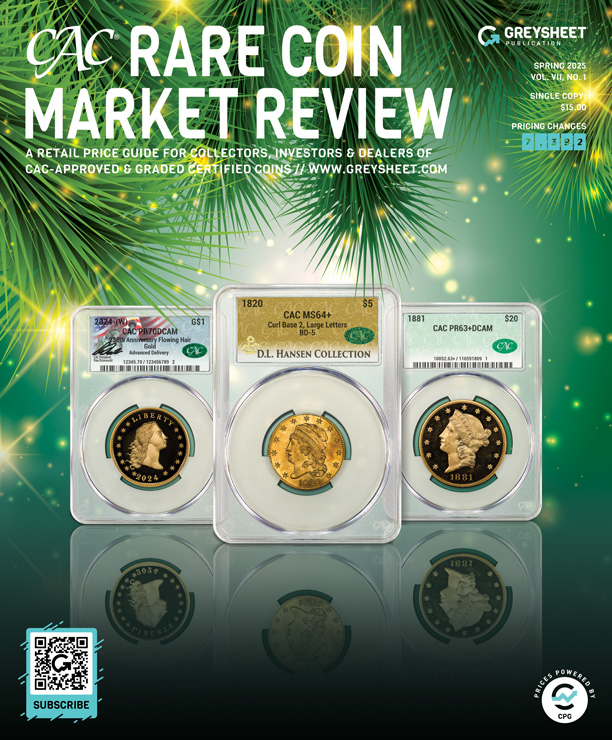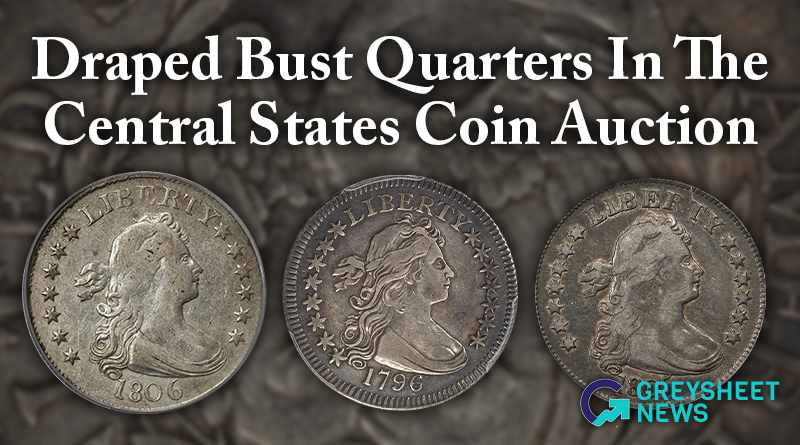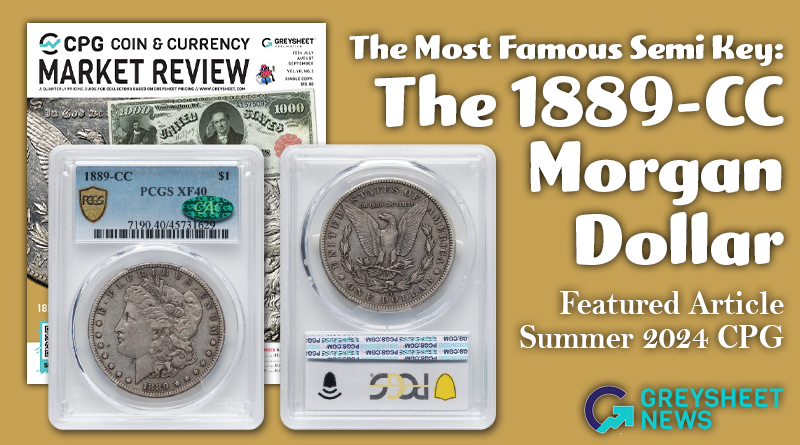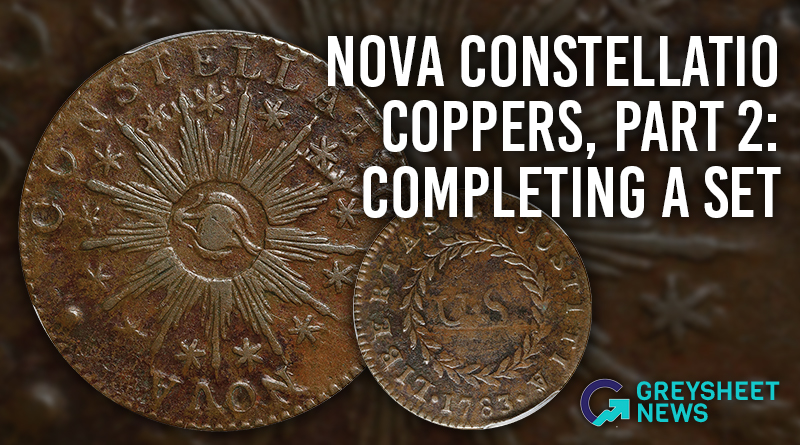CAC Coins For Less Than $150 Each, Part 6: Mercury Dimes
IT IS PRACTICAL to come fairly close to completing a CAC-only set of Mercury dimes without spending more than $150 on any one coin.
Mercury dimes were minted from 1916 to 1945. They were struck at the Philadelphia, Denver and San Francisco Mints. Dimes of any type struck at the Philadelphia Mint did not have a mintmark until 1980. Denver Mint coins each have a D mintmark and an S signifies San Francisco.
Grading services designate Mercury dimes that are found to have fully split horizontal bands in the middle of the reverse (back of the coin) as “FB.” Personally, I am astonished that so many coin buyers find the precise details of these bands to be so important and are willing to pay extremely large premiums in many cases (https://tinyurl.com/FullBandsGoneTooFar).
Budget-minded buyers should probably focus on the cost of each coin rather than think much about ‘fully split bands.’ The costs and availability of dates in the series are considered here.
Back on May 17, 2020, the firm called GreatCollections sold a CAC approved, NGC graded MS64 1916 Mercury dime for $74.25. While this coin could easily bring more if offered in 2023, it probably would not not bring all that much more.
The 1916-D is the key date. It is unlikely that a CAC approved 1916-D dime could be purchased for less than $150. It is not unusual, however, for a collector to assemble a set of Mercury dimes that lacks a 1916-D. There are many collectors who cannot afford one.
A CAC approved 1916-S that grades below MS64 would probably retail for less than $150, if one could be found. On August 18, 2019, GreatCollections sold a CAC approved, NGC certified MS64FB 1917 for $104.62. In grades above Fine-12, a 1917-D tends to be worth more than three times as much as a 1917 Philadelphia Mint dime with the same respective certification.

Examples of CAC-approved Mercury dimes you should be able to acquire under $150
As of November 20, 2022, CAC has approved one 1917-D as AU53, one as AU55 and seven as AU58. All nine of these and other circulated 1917-D dimes that might be submitted to CAC are CPG® estimated to have current retail values below $150 each. Alternatively, a collector could buy a raw Very Fine grade 1917-D for around $30. Even if a particular raw 1917-D does not turn out to be a decent coin, $30 is not a lot to lose in the field of collecting classic U.S. coins.
A coin that is not encapsulated and is apparently uncertified is raw. While it may seem odd to suggest buying raw coins in a discussion about building a CAC-only set of Mercs, very inexpensive, circulated raw Mercs can later be submitted for certification.
Any CAC approved, circulated 1917-S dime would probably retail for less than $120 in 2023, if one is offered. On the whole, a small number of sub-60 grade Mercury dimes have been submitted to CAC. Most Mercury dimes that were submitted to CAC from 2007 to 2022 were earlier graded above MS63 by PCGS or NGC.
The planned expansion of CAC in 2023 will probably make building a set of inexpensive CAC approved Mercury dimes an even more practical objective than it was in 2022. There is a good chance that the population of CAC approved, circulated (sub-60 grade) Mercury dimes will become greater in the future.
If an uncertified (raw) Mercury dime was worth less than $150, in order for it to have received a CAC sticker before 2023, it would have had to be submitted first to PCGS or NGC and then later to CAC. Therefore, two grading fees would have been paid and transportation costs to two services would have been incurred. Beginning at some point in 2023, raw U.S. coins may be submitted to a new CAC Grading office in Virginia where acceptable coins will be graded and encapsulated by CAC Grading.
The low population of CAC approved, sub-60 grade Mercury dimes notwithstanding, they are around. Some public sales of them are cited here to provide an idea of the costs and practicality of building an almost complete set of CAC approved Mercury dimes, without spending more than $150 on any one coin. Undoubtedly, there have been many private sales of CAC approved, circulated pieces, of which I am unaware.
On May 30, 2021, GreatCollections sold a CAC approved XF45 grade 1919-S for $94.50. On March 1, 2020, GreatCollections sold a CAC approved AU55 grade 1920-S for $83.27 and a CAC approved AU58 1920-S for $123.75.
The 1921 and the 1921-D are semi-keys. A VF20 grade 1921 or 1921-D would be likely to cost much more than $150. On June 19, 2022, the firm of David Lawrence (DLRC) sold a CAC approved, PCGS graded VG8 1921 dime for $115. CAC has approved more than a dozen 1921-D dimes that should in theory retail for less than $150 each.
There are no 1921-S Mercs. Furthermore, no dimes were minted in 1922. In an article in a past CDN-Greysheet publication, I explain the reasons why U.S. coin mintages were low in 1921 and 1922 (https://www.greysheet.com/news/story/panic-of-1921-spawned-famous-coins).
The CPG® retail estimate for a raw VF20 grade 1923 is just $3.71. There are no 1923-D dimes, and the retail estimate for the 1923-S is $18.90. The CPG® retail estimates for VF20 grade 1924, 1924-D and 1924-S Mercs are $4.73, $24.64 and $20.25 respectively.
To complete a CAC-only set of circulated Mercury dimes for less than $150 each in the near future, there would probably be a need to submit some Mercury dimes to CAC or to ask dealers to do so. Of course, I am not suggesting that such submissions would be financially profitable. I am suggesting that such submissions could very well serve an educational purpose.
By carefully inspecting raw coins, submitting them to CAC, and reflecting upon the results, some collectors practice grading and learn about CAC grading criteria. Inexpensive, common representatives of a classic U.S. design type are frequently useful for learning.
Regarding dimes from the 1920s and early 1930s, it might be surprisingly hard to find attractive and technically impressive, naturally toned coins in VF to XF grades. If I had time to do so, I would enjoy searching for them and then sending them to the CAC Grading office in Virginia after it opens.
If there were any CAC approved 1926-S dimes in grades below VF30, they would retail for less than $150 each. As of November 2022, the CPG ®-CAC medium retail estimate is $358 for a 1926-S in XF40 grade. There must a noteworthy number of Fine-12 to VF30 grade 1926-S dimes that have never been submitted to CAC.
It is already possible to buy CAC approved representatives of most relatively scarce Mercury dimes for less than $150 each. It just may require patience to acquire them. Back on December 22, 2020, Heritage sold a CAC approved, NGC graded XF40 1927-D for $97. On March 1, 2020, GreatCollections sold a CAC approved AU55 grade 1928-D for $109.12. On January 19, 2020, GreatCollections sold a CAC approved, NGC certified MS63FB 1929-D dime for $69.75.
As for Mercury dimes from 1930 and 1931, CAC approved circulated representatives of all these would cost less than $150 each if they were available. For example, all sub-63 grade 1931-D dimes are CPG® estimated to retail for less than $150 each, yet CAC has approved just one sub-63 grade 1931-S in this range, a Fine-12 grade 1931-D that is CPG ® estimated to have a retail value of $19. A raw VF to XF grade 1931-D could be purchased for a price in the range of $25 to $60 and submitted to the CAC Grading office in Virginia after it opens.
There are no 1932 or 1933 dimes. Most regular issue U.S. coins minted from 1934 onward are rather plentiful. Collecting U.S. coins minted after 1934 is really a hobby that is different from collecting pre-1934 coins, which I call classic U.S. coins.
Dimes minted after 1934 are so common in uncirculated (mint state) grades that little attention is paid to circulated coins. Many of these are sold as ‘junk silver,’ often in bags with post-1934 silver coins of other denominations. A set of circulated Mercury dimes should probably end with a 1934 dime. MS63 to MS67 grade representatives of the late dates (1934–45) may easily be acquired.
On October 16, 2019, Stack’s Bowers sold a PCGS certified MS66+FB 1934 dime, with a CAC sticker, for $100. On January 3, 2021, GreatCollections sold a CAC approved MS66 grade 1934-D for $126.12.
On July 31, 2022, GreatCollections sold a CAC approved MS65FB 1935 dime for $103.50. On May 15, 2022, GreatCollections sold a CAC approved, NGC graded MS67 1936 dime for $94.50. On June 10, 2018, the Goldbergs sold a CAC approved MS64FB 1936-D for $108. On September 22, 2019, GreatCollections sold a CAC approved MS66FB 1936-S dime for $140.62. Over the last few years, market levels for Mercury dimes have not risen very much.
On October 16, 2019, Stack’s Bowers sold a CAC approved MS67 grade 1937 dime for $75. On October 27, 2020, Heritage sold a CAC approved MS66FB 1937-D for $133.20. On May 29, 2022, GreatCollections sold a CAC approved MS66 grade 1937-S for $112.50.
Generally, Mercury dimes from the 1940s are even more common than those dating from 1934 to 1939. The 1942/1 and 1942/1-D overdates are exceptions. They cannot be acquired for less than $150 each with a CAC sticker. These are unusual varieties that many collectors just ignore. Besides, the 1942/1 is more convincing as an overdate than the 1942/1-D, which seems to be a slightly recut date, really an obscure variety that requires magnification to interpret. A collector who is willing to make exceptions to an under $150 rule may splurge and buy a CAC approved, well worn 1942/1 dime for less than $550 and a 1916-D for under $1,500.
While it is a very realistic possibility that the CAC population of inexpensive Mercury dimes will substantially increase during the next few years, it is practical and sensible to begin a set now. It is a good idea to proceed slowly. While some CAC approved Mercury dimes can be purchased for less than $150 each in public auctions, more can be found at coin shows or through pertinent dealers.
Copyright ©2023 Greg Reynolds
Insightful10@gmail.com
Images appear courtesy of the respective auction firms: David Lawrence Rare Coins, Heritage, Stack’s Bowers, and GreatCollections.

Download the Greysheet app for access to pricing, news, events and your subscriptions.
Subscribe Now.

Subscribe to CAC Rare Coin Market Review for the industry's most respected pricing and to read more articles just like this.
Source: Greg Reynolds
Related Stories (powered by Greysheet News)
View all news
The Lusk set of Draped Bust quarters brought strong results.

The 1889-CC is the second scarcest business strike in the series.

Just six coins are required for a set of true Nova Constellatio Coppers, and the coins selected need not be very expensive.









Please sign in or register to leave a comment.
Your identity will be restricted to first name/last initial, or a user ID you create.
Comment
Comments